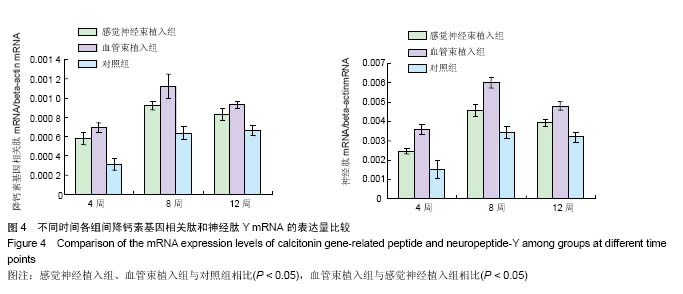中国组织工程研究 ›› 2017, Vol. 21 ›› Issue (8): 1161-1166.doi: 10.3969/j.issn.2095-4344.2017.08.003
• 骨组织构建 bone tissue construction • 上一篇 下一篇
植入单纯血管束、感觉神经束的组织工程骨修复大段骨缺损
覃俊君1,尹 东1,裴国献2,江 汕3,陈思圆4,王 簕5,穆天旺6,李明东7
- 1广西壮族自治区人民医院骨科,广西壮族自治区南宁市 530021;2解放军第四军医大学西京医院骨科,陕西省西安市 710032;3南方医科大学第一临床医学院,广东省广州市 510515;4广东医科大学附属医院骨科,广东省湛江市 524001;5广州医科大学附属第三医院骨科,广东省广州市 510150;6深圳市第九医院骨科,广东省深圳市 518116;7海南省人民医院创伤骨科,海南省海口市 570311
Tissue-engineered bone with vascular bundles or sensory nerve tracts for repairing large bone defects
Qin Jun-jun1, Yin Dong1, Pei Guo-xian2, Jiang Shan3, Chen Si-yuan4, Wang Le5, Mu Tian-wang6, Li Ming-dong7
- 1Department of Orthopedics, the People’s Hospital of Guangxi Zhuang Autonomous Region, Nanning 530021, Guangxi Zhuang Autonomous Region, China; 2Department of Orthopedics, Xijing Hospital of the Fourth Military Medical University, Xi’an 710032, Shaanxi Province, China; 3Nanfang Hospital of Southern Medical University, Guangzhou 510515, Guangdong Province, China; 4Department of Orthopedics, Affiliated Hospital of Guangdong Medical University, Zhanjiang 524001, Guangdong Province, China; 5Department of Orthopaedics, the Third Affiliated Hospital of Guangzhou University, Guangzhou 510150, Guangdong Province, China; 6Department of Orthopaedics, the Third People’s Hospital of Shenzhen, Shenzhen 518116, Guangdong Province, China; 7Department of Traumatic Orthopedics, Hainan General Hospital, Haikou 570311, Hainan Province, China
摘要:
文章快速阅读:
.jpg) 文题释义:
降钙素基因相关肽:是广泛分布于神经系统的一种神经肽,其在外周及脊髓参与伤害性信息的传递及痛敏化的形成,并与P物质、兴奋性氨基酸、辣椒素1型受体、趋化因子、激活素、大麻素受体、阿片受体、神经生长因子、血管活性肠肽、5-羟色胺、糖皮质激素等生物活性物质或受体在痛觉调制过程中存在相互影响。
神经肽Y:是一种广泛存在于中枢和外周并维持内环境稳态的激素,它在许多方面调节或参与肾上腺素能神经的作用。
文题释义:
降钙素基因相关肽:是广泛分布于神经系统的一种神经肽,其在外周及脊髓参与伤害性信息的传递及痛敏化的形成,并与P物质、兴奋性氨基酸、辣椒素1型受体、趋化因子、激活素、大麻素受体、阿片受体、神经生长因子、血管活性肠肽、5-羟色胺、糖皮质激素等生物活性物质或受体在痛觉调制过程中存在相互影响。
神经肽Y:是一种广泛存在于中枢和外周并维持内环境稳态的激素,它在许多方面调节或参与肾上腺素能神经的作用。
.jpg) 文题释义:
降钙素基因相关肽:是广泛分布于神经系统的一种神经肽,其在外周及脊髓参与伤害性信息的传递及痛敏化的形成,并与P物质、兴奋性氨基酸、辣椒素1型受体、趋化因子、激活素、大麻素受体、阿片受体、神经生长因子、血管活性肠肽、5-羟色胺、糖皮质激素等生物活性物质或受体在痛觉调制过程中存在相互影响。
神经肽Y:是一种广泛存在于中枢和外周并维持内环境稳态的激素,它在许多方面调节或参与肾上腺素能神经的作用。
文题释义:
降钙素基因相关肽:是广泛分布于神经系统的一种神经肽,其在外周及脊髓参与伤害性信息的传递及痛敏化的形成,并与P物质、兴奋性氨基酸、辣椒素1型受体、趋化因子、激活素、大麻素受体、阿片受体、神经生长因子、血管活性肠肽、5-羟色胺、糖皮质激素等生物活性物质或受体在痛觉调制过程中存在相互影响。
神经肽Y:是一种广泛存在于中枢和外周并维持内环境稳态的激素,它在许多方面调节或参与肾上腺素能神经的作用。摘要
背景:神经肽作为存在于神经组织的一种内源性活性物质,作用于全身多个系统,调节体内各系统生理功能。
目的:观察分别植入单纯血管束、感觉神经束的组织工程骨修复兔大段骨缺损对降钙素基因相关肽、神经肽Y表达的影响。
方法:新西兰兔共54只制备股骨大段骨缺损模型,以随机抽签法分为感觉神经束植入组、血管束植入组及对照组,每组各18只,分别给予单纯感觉神经束植入、单纯血管束植入及无血管神经束组织工程骨(对照组)修复治疗,分别于造模后4,8,12周对修复骨段行大体、Masson染色观察,比较修复骨段内降钙素基因相关肽和神经肽Y表达水平。
结果与结论:①造模后4,8,12周,感觉神经束植入、血管束植入组降钙素基因相关肽和神经肽Y mRNA表达水平均显著高于对照组(P < 0.05);②组织工程骨内降钙素基因相关肽和神经肽Y mRNA表达水平随时间增加先增高后下降,其中第8周降钙素基因相关肽和神经肽Y mRNA表达水平显著高于第4,12周(P < 0.05);且第4周降钙素基因相关肽和神经肽Y mRNA表达水平显著低于其他时间点(P < 0.05);③组织工程骨内降钙素基因相关肽主要表达于新生骨骨质边缘、骨膜及血管外周;神经肽Y主要表达于髓腔及血管外周;④结果说明,骨缺损中血管束或感觉神经束植入均可显著上调神经肽降钙素基因相关肽和神经肽Y合成水平,加快骨质修复进程;但感觉神经束植入组织工程骨可能引起支配区感觉功能丧失,故血管束植入更符合正常人体生理功能需求。
中国组织工程研究杂志出版内容重点:组织构建;骨细胞;软骨细胞;细胞培养;成纤维细胞;血管内皮细胞;骨质疏松;组织工程
ORCID: 0000-0001-7522-2829(覃俊君)
中图分类号:


.jpg) 文题释义:
降钙素基因相关肽:是广泛分布于神经系统的一种神经肽,其在外周及脊髓参与伤害性信息的传递及痛敏化的形成,并与P物质、兴奋性氨基酸、辣椒素1型受体、趋化因子、激活素、大麻素受体、阿片受体、神经生长因子、血管活性肠肽、5-羟色胺、糖皮质激素等生物活性物质或受体在痛觉调制过程中存在相互影响。
神经肽Y:是一种广泛存在于中枢和外周并维持内环境稳态的激素,它在许多方面调节或参与肾上腺素能神经的作用。
文题释义:
降钙素基因相关肽:是广泛分布于神经系统的一种神经肽,其在外周及脊髓参与伤害性信息的传递及痛敏化的形成,并与P物质、兴奋性氨基酸、辣椒素1型受体、趋化因子、激活素、大麻素受体、阿片受体、神经生长因子、血管活性肠肽、5-羟色胺、糖皮质激素等生物活性物质或受体在痛觉调制过程中存在相互影响。
神经肽Y:是一种广泛存在于中枢和外周并维持内环境稳态的激素,它在许多方面调节或参与肾上腺素能神经的作用。